DeWalt DW968 Handleiding
DeWalt
Boormachine
DW968
Bekijk gratis de handleiding van DeWalt DW968 (7 pagina’s), behorend tot de categorie Boormachine. Deze gids werd als nuttig beoordeeld door 52 mensen en kreeg gemiddeld 4.8 sterren uit 26.5 reviews. Heb je een vraag over DeWalt DW968 of wil je andere gebruikers van dit product iets vragen? Stel een vraag
Pagina 1/7

INSTRUCTION MANUAL
GUIDE D'UTILISATION
MANUAL DE INSTRUCCIONES
DC668, DW968, DW969
Cordless Light Gauge Steel Framing Screwdriver
Visseuses à charpente métallique, de faible calibre et sans fil
Destornilladores inalámbricos con enmarcado de acero de bajo calibre
INSTRUCTIVO DE OPERACIÓN, CENTROS DE SERVICIO Y PÓLIZA
DE GARANTÍA. ADVERTENCIA: LÉASE ESTE INSTRUCTIVO
ANTES DE USAR EL PRODUCTO.
IF YOU HAVE ANY QUESTIONS OR COMMENTS ABOUT THIS OR ANY DEWALT TOOL,
CALL US TOLL FREE AT: 1-800-4-DEWALT (1-800-433-9258)
General Safety Rules
WARNING! Read all instructions. Failure to follow all instructions listed below may
result in electric shock, fire and/or serious injury. The term “power tool” in all of the
warnings listed below refers to your mains-operated (corded) power tool or battery-
operated (cordless) power tool.
SAVE THESE INSTRUCTIONS
1) WORK AREA SAFETY
a) Keep work area clean and well lit. Cluttered or dark areas invite accidents.
b) Do not operate power tools in explosive atmospheres, such as in the presence of
flammable liquids, gases or dust. Power tools create sparks which may ignite the dust
or fumes.
c) Keep children and bystanders away while operating a power tool. Distractions can
cause you to lose control
2) ELECTRICAL SAFETY
a) Power tool plugs must match the outlet. Never modify the plug in any way. Do not
use any adapter plugs with earthed (grounded) power tools. Unmodified plugs and
matching outlets will reduce risk of electric shock
b) Avoid body contact with earthed or grounded surfaces such as pipes, radiators,
ranges and refrigerators. There is an increased risk of electric shock if your body is
earthed or grounded.
c) Do not expose power tools to rain or wet conditions. Water entering a power tool will
increase the risk of electric shock
d) Do not abuse the cord. Never use the cord for carrying, pulling or unplugging the
power tool. Keep cord away from heat, oil, sharp edges or moving parts. Damaged
or entangled cords increase the risk of electric shock. Replace or repair damaged cords.
Make sure your extension cord is in good condition. Use only 3-wire extension cords that
have 3-prong grounding-type plugs and 3-pole receptacles that accept the tool’s plug.
e) When operating a power tool outdoors, use an extension cord suitable for outdoor
use. Use of a cord suitable for outdoor use reduces the risk of electric shock. When using
an extension cord, be sure to use one heavy enough to carry the current your product will
draw. An undersized cord will cause a drop in line voltage resulting in loss of power and
overheating. The following table shows the correct size to use depending on cord length
and nameplate ampere rating. If in doubt, use the next heavier gage. The smaller the gage
number, the heavier the cord.
Recommended Minimum Wire Size for Extension Cords
Total Length of Cord
25 ft. 50 ft. 75 ft. 100 ft. 125 ft. 150 ft. 175 ft.
7.6 m 15.2 m 22.9 m 30.5 m 38.1 m 45.7 m 53.3 m
Wire Size AWG
18 18 16 16 14 14 12
3) PERSONAL SAFETY
a) Stay alert, watch what you are doing and use common sense when operating a
power tool. Do not use a power tool while you are tired or under the influence of
drugs, alcohol or medication. A moment of inattention while operating power toolsmay
result in serious personal injury.
b) Use safety equipment. Always wear eye protection. Safety equipment such as
dust mask, non-skid safety shoes, hard hat, or hearing protection used for appropriate
conditions will reduce personal injuries.
c) Avoid accidental starting. Ensure the switch is in the off-position before plugging in.
Carrying power tools with your finger on the switch or plugging in power tools that have the
switch on invites accidents.
d) Remove any adjusting key or wrench before turning the power tool on. A wrench or
a key left attached to a rotating part of the power tool may result in personal injury.
e) Do not overreach. Keep proper footing and balance at all times. This enables better
control of the power tool in unexpected situations.
f) Dress properly. Do not wear loose clothing or jewellery. Keep your hair, clothing and
gloves away from moving parts. Loose clothes, jewellery or long hair can be caught in
moving parts. Air vents often cover moving parts and should also be avoided.
g) If devices are provided for the connection of dust extraction and collection facilities,
ensure these are connected and properly used. Use of these devices can reduce dust-
related hazards.
4) POWER TOOL USE AND CARE
a) Do not force the power tool. Use the correct power tool for your application. The
correct power tool will do the job better and safer at the rate for which it was designed.
b) Do not use the power tool if the switch does not turn it on and off. Any power tool that
cannot be controlled with the switch is dangerous and must be repaired.
c) Disconnect the plug from the power source and/or the battery pack from the power
tool before making any adjustments, changing accessories, or storing power tools.
Such preventive safety measures reduce the risk of starting the power tool accidentally.
d) Store idle power tools out of the reach of children and do not allow persons unfa-
miliar with the power tool or these instructions to operate the power tool. Power
tools are dangerous in the hands of untrained users.
e) Maintain power tools. Check for misalignment or binding of moving parts, breakage
of parts and any other condition that may affect the power tools operation. If
damaged, have the power tool repaired before use. Many accidents are caused by
poorly maintained power tools.
f) Keep cutting tools sharp and clean. Properly maintained cutting tools with sharp cutting
edges are less likely to bind and are easier to control.
g) Use the power tool, accessories and tool bits etc., in accordance with these instruc-
tions and in the manner intended for the particular type of power tool, taking into
account the working conditions and the work to be performed. Use of the power tool
for operations different from those intended could result in a hazardous situation.
5) BATTERY TOOL USE AND CARE
a) Ensure the switch is in the off position before inserting battery pack. Inserting the
battery pack into power tools that have the switch on invites accidents.
b) Recharge only with the charger specified by the manufacturer. A charger that is
suitable for one type of battery pack may create a risk of fire when used with another
battery pack.
c) Use power tools only with specifically designated battery packs. Use of any other
battery packs may create a risk of injury and fire.
d) When battery pack is not in use, keep it away from other metal objects like paper
clips, coins, keys, nails, screws, or other small metal objects that can make a
connection from one terminal to another. Shorting the battery terminals together may
cause burns or a fire.
e) Under abusive conditions, liquid may be ejected from the battery, avoid contact. If
contact accidentally occurs, flush with water. If liquid contacts eyes, additionally
seek medical help. Liquid ejected from the battery may cause irritation or burns.
6) SERVICE
a) Have your power tool serviced by a qualified repair person using only identical
replacement parts. This will ensure that the safety of the power tool is maintained.
Additional Safety Instructions
•Hold tool by insulated gripping surfaces when performing an operation where the
cutting tool may contact hidden wiring or its own cord. Contact with a “live” wire will
make exposed metal parts of the tool “live” and shock the operator.
CAUTION: Wear appropriate personal hearing protection during use. Under some
conditions and duration of use, noise from this product may contribute to hearing loss.
CAUTION: When not in use, place tool on its side on a stable surface where it will not
cause a tripping or falling hazard. Some tools with large battery packs will stand upright on
the battery pack but may be easily knocked over.
WARNING: Some dust created by power sanding, sawing, grinding, drilling, and other
construction activities contains chemicals known to cause cancer, birth defects or other repro-
ductive harm. Some examples of these chemicals are:
• lead from lead-based paints,
• crystalline silica from bricks and cement and other masonry products, and
• arsenic and chromium from chemically-treated lumber (CCA).
Your risk from these exposures varies, depending on how often you do this type of work. To
reduce your exposure to these chemicals: work in a well ventilated area, and work with
approved safety equipment, such as those dust masks that are specially designed to filter out
microscopic particles.
•Avoid prolonged contact with dust from power sanding, sawing, grinding, drilling, and
other construction activities. Wear protective clothing and wash exposed areas with
soap and water. Allowing dust to get into your mouth, eyes, or lay on the skin may promote
absorption of harmful chemicals.
WARNING: Use of this tool can generate and/or disburse dust, which may cause serious and
permanent respiratory or other injury. Always use NIOSH/OSHA approved respiratory protection
appropriate for the dust exposure. Direct particles away from face and body.
• The label on your tool may include the following symbols. The symbols and their definitions
are as follows:
V ..................volts A ....................amperes
Hz ................hertz W ....................watts
min ..............minutes ..................alternating current
............direct current no....................no load speed
................Class I Construction ....................earthing terminal
....................(grounded) ....................safety alert symbol
..................Class II Construction …/min ............revolutions or reciprocation
....................(double insulated) ........................per minute
BPM ............beats per minute
Important Safety Instructions for Battery Packs
When ordering replacement battery packs, be sure to include catalog number and voltage:
Extended Run-Time battery packs deliver more run-time than standard battery packs. Consult
the chart at the end of this manual for compatibility of chargers and battery packs.
NOTE: Your tool will accept either standard or Extended Run Time battery packs. However, be
sure to select proper voltage. Batteries slowly lose their charge when they are not on the
charger, the best place to keep your battery is on the charger at all times.
The battery pack is not fully charged out of the carton. Before using the battery pack and
charger, read the safety instructions below. Then follow charging procedures outlined.
READ ALL INSTRUCTIONS
•Do not incinerate the battery pack even if it is severely damaged or is completely worn
out. The battery pack can explode in a fire.
•A small leakage of liquid from the battery pack cells may occur under extreme usage
or temperature conditions. This does not indicate a failure. However, if the outer seal is
broken and this leakage gets on your skin:
a. Wash quickly with soap and water.
b. Neutralize with a mild acid such as lemon juice or vinegar.
c. If battery liquid gets into your eyes, flush them with clean water for a minimum of
10 minutes and seek immediate medical attention. ( The liquid is 25-35%Medical note:
solution of potassium hydroxide.)
• Charge the battery packs only in DEWALT chargers.
•DO NOT splash or immerse in water or other liquids.
• Do not store or use the tool and battery pack in locations where the temperature may
reach or exceed 105°F (such as outside sheds or metal buildings in summer).
DANGER: Electrocution hazard. Never attempt to open the battery pack for any reason. If
battery pack case is cracked or damaged, do not insert into charger. Electric shock or electro-
cution may result. Damaged battery packs should be returned to service center for recycling.
NOTE: Battery storage and carrying caps are provided for use whenever the
battery is out of the tool or charger. Remove cap before placing battery in
charger or tool.
WARNING: Fire hazard. Do not store or carry battery so that metal objects
can contact exposed battery terminals. For example, do not place battery in
aprons, pockets, tool boxes, product kit boxes, drawers, etc., with loose nails,
screws, keys, etc. without battery cap. Transporting batteries can possibly cause fires if the
battery terminals inadvertently come in contact with conductive materials such as keys,
coins, hand tools and the like. The US Department of Transportation Hazardous Material
Regulations (HMR) actually prohibit transporting batteries in commerce or on airplanes (i.e.,
packed in suitcases and carry-on luggage) UNLESS they are properly protected from short
circuits. So when transporting individual batteries, make sure that the battery terminals are
protected and well insulated from materials that could contact them and cause a short circuit.
The RBRC™ Seal
The RBRC™ (Rechargeable Battery Recycling Corporation) Seal on the
nickel cadmium and nickel metal hydride batteries (or battery packs) indicate that
the costs to recycle these batteries (or battery packs) at the end of their useful life
have already been paid by DEWALT. In some areas, it is illegal to place spent
nickel cadmium and nickel metal hydride batteries in the trash or municipal solid
waste stream and the RBRC program provides an environmentally conscious alternative.
RBRC™ in cooperation with DEWALT and other battery users, has established programs in the
United States and Canada to facilitate the collection of spent nickel cadmium and nickel metal
hydride batteries. Help protect our environment and conserve natural resources by returning
the spent nickel cadmium and nickel metal hydride batteries to an authorized DEWALT service
center or to your local retailer for recycling. You may also contact your local recycling center for
information on where to drop off the spent battery.
RBRC™ is a registered trademark of the
Rechargeable Battery Recycling Corporation.
Important Safety Instructions for Battery Chargers
SAVE THESE INSTRUCTIONS: This manual contains important safety instructions for battery
chargers.
• Before using charger, read all instructions and cautionary markings on charger, battery pack,
and product using battery pack.
DANGER: Electrocution hazard. 120 volts are present at charging terminals. Do not probe with
conductive objects.
WARNING: Shock hazard. Do not allow any liquid to get inside charger.
DEWALT Industrial Tool Co., 701 East Joppa Road, Baltimore, MD 21286
(JUL06) Form No. 631171-00 DC668, DW968, DW969 Copyright © 2005, 2006 DEWALT
The following are trademarks for one or more D WALT power tools: the yellow and black colorE
scheme; the “D” shaped air intake grill; the array of pyramids on the handgrip; the kit box
configuration; and the array of lozenge-shaped humps on the surface of the tool.
If you have questions or comments, contact us.
Pour toute question ou tout commentaire, nous contacter.
Si tiene dudas o comentarios, contáctenos.
1-800-4-DEWALT • www.dewalt.com

CAUTION: Burn hazard. To reduce the risk of injury, charge only D
E
WALT rechargeable
batteries. Other types of batteries may burst causing personal injury and damage.
CAUTION: Under certain conditions, with the charger plugged in to the power supply, the
exposed charging contacts inside the charger can be shorted by foreign material. Foreign mate-
rials of a conductive nature such as, but not limited to, steel wool, aluminum foil, or any buildup
of metallic particles should be kept away from charger cavities. Always unplug the charger from
the power supply when there is no battery pack in the cavity. Unplug charger before attempting
to clean.
•DO NOT attempt to charge the battery pack with any chargers other than the ones in
this manual. The charger and battery pack are specifically designed to work together.
•These chargers are not intended for any uses other than charging DEWALT recharge-
able batteries. Any other uses may result in risk of fire, electric shock or electrocution.
•Do not expose charger to rain or snow.
•Pull by plug rather than cord when disconnecting charger. This will reduce risk of
damage to electric plug and cord.
•Make sure that cord is located so that it will not be stepped on, tripped over, or other-
wise subjected to damage or stress.
•Do not use an extension cord unless it is absolutely necessary. Use of improper
extension cord could result in risk of fire, electric shock, or electrocution.
•An extension cord must have adequate wire size (AWG or American Wire Gauge) for
safety. The smaller the gauge number of the wire, the greater the capacity of the cable, that
is 16 gauge has more capacity than 18 gauge. When using more than one extension to make
up the total length, be sure each individual extension contains at least the minimum wire size.
•Do not place any object on top of charger or place the charger on a soft surface that
might block the ventilation slots and result in excessive internal heat. Place the
charger in a position away from any heat source. The charger is ventilated through slots in
the top and the bottom of the housing.
•Do not operate charger with damaged cord or plug — have them replaced immediately.
•Do not operate charger if it has received a sharp blow, been dropped, or otherwise
damaged in any way. Take it to an authorized service center.
•Do not disassemble charger; take it to an authorized service center when service or
repair is required. Incorrect reassembly may result in a risk of electric shock, electrocution
or fire.
•Disconnect the charger from the outlet before attempting any cleaning. This will
reduce the risk of electric shock. Removing the battery pack will not reduce this risk.
•NEVER attempt to connect 2 chargers together.
•The charger is designed to operate on standard household electrical power (120
Volts). Do not attempt to use it on any other voltage. This does not apply to the
vehicular charger.
Using Automatic Tune-Up™ Mode
The automatic Tune-Up™ Mode equalizes or balances the individual cells in the battery pack
allowing it to function at peak capacity. Battery packs should be tuned up weekly or after 10
charge/discharge cycles or whenever the pack no longer delivers the same amount of work. To
use the automatic Tune-Up™, place the battery pack in the charger and leave it for at least 8
hours. The charger will cycle through the following modes.
1. The red light will blink continuously indicating that the 1-hour charge cycle has started.
2. When the 1-hour charge cycle is complete, the light will stay on continuously and will no
longer blink. This indicates that the pack is fully charged and can be used at this time.
3. If the pack is left in the charger after the initial 1-hour charge, the charger will begin the
Automatic Tune-Up mode. This mode continues up to 8 hours or until the individual cells in
the battery pack are equalized. The battery pack is ready for use and can be removed at any
time during the Tune-Up mode.
4. Once the Automatic Tune Up mode is complete, the charger will begin a maintenance
charge; the red indicator will remain lit.
SAVE THESE INSTRUCTIONS FOR FUTURE USE
Chargers
Your battery can be charged in D WALT 1 Hour Chargers, 15 Minute Chargers or Vehicular E
12 Volt Charger. Be sure to read all safety instructions before using your charger. Consult the
chart at the end of this manual for compatibility of chargers and battery packs.
Charging Procedure
DANGER: Electrocution hazard. 120 volts are present at charging terminals. Do not probe with
conductive objects.
1. Plug the charger into an appropriate outlet as shown in Figure 1.
2. Insert the battery pack into the charger. The red (charging) light will blink continuously
indicating that the charging process has started.
3. The completion of charge will be indicated by the red light remaining ON continuously. The
pack is fully charged and may be used at this time or left in the charger.
Indicator Light Operation
Charge Indicators
Some chargers are designed to detect certain problems that can arise with battery packs.
Problems are indicated by the red light flashing at a fast rate. If this occurs, re-insert battery
pack into the charger. If the problem persists, try a different battery pack to determine if the
charger is OK. If the new pack charges correctly, then the original pack is defective and should
be returned to a service center or other collection site for recycling. If the new battery pack
elicits the same trouble indication as the original, have the charger tested at an authorized ser-
vice center.
HOT/COLD PACK DELAY
Some chargers have a Hot/Cold Pack Delay feature: when the charger detects a battery that is
hot, it automatically starts a Hot Pack Delay, suspending charging until the battery has cooled.
After the battery has cooled, the charger automatically switches to the Pack Charging mode.
This feature ensures maximum battery life. The red light flashes long, then short while in the Hot
Pack Delay mode.
PROBLEM POWER LINE
Some chargers have a Problem Power Line indicator. When the charger is used with some
portable power sources such as generators or sources that convert DC to AC, the charger may
temporarily suspend operation, flashing the red light with two fast blinks followed by a
pause. This indicates the power source is out of limits.
LEAVING THE BATTERY PACK IN THE CHARGER
The charger and battery pack can be left connected with the red light glowing indefinitely. The
charger will keep the battery pack fresh and fully charged.
NOTE: A battery pack will slowly lose its charge when kept out of the charger. If the battery pack
has not been kept on maintenance charge, it may need to be recharged before use. A battery
pack may also slowly lose its charge if left in a charger that is not plugged into an appropriate
AC source.
WEAK BATTERY PACKS: Chargers can also detect a weak battery. Such batteries are still
usable but should not be expected to perform as much work. In such cases, about 10 seconds
after battery insertion, the charger will beep rapidly 8 times to indicate a weak battery condition.
The charger will then go on to charge the battery to the highest capacity possible.
Important Charging Notes
1. Longest life and best performance can be obtained if the battery pack is charged when the
air temperature is between 65°F and 75°F (18°- 24°C). DO NOT charge the battery pack in
an air temperature below +40°F (+4.5°C), or above +105°F (+40.5°C). This is important and
will prevent serious damage to the battery pack.
2. The charger and battery pack may become warm to touch while charging. This is a normal
condition, and does not indicate a problem. To facilitate the cooling of the battery pack after
use, avoid placing the charger or battery pack in a warm environment such as in a metal
shed, or an uninsulated trailer.
3. If the battery pack does not charge properly:
a. Check current at receptacle by plugging in a lamp or other appliance
b. Check to see if receptacle is connected to a light switch which turns power off when you
turn out the lights.
c. Move charger and battery pack to a location where the surrounding air temperature is
approximately 65°F - 75°F (18°- 24°C).
d. If charging problems persist, take the tool, battery pack and charger to your local
service center.
4. The battery pack should be recharged when it fails to produce sufficient power on jobs which
were easily done previously. DO NOT CONTINUE to use under these conditions. Follow the
charging procedure. You may also charge a partially used pack whenever you desire with no
adverse affect on the battery pack.
5. Under certain conditions, with the charger plugged into the power supply, the exposed
charging contacts inside the charger can be shorted by foreign material. Foreign materials
of a conductive nature such as, but not limited to, steel wool, aluminum foil, or any buildup
of metallic particles should be kept away from charger cavities. Always unplug the charger
from the power supply when there is no battery pack in the cavity. Unplug charger before
attempting to clean.
6. Do not freeze or immerse charger in water or any other liquid.
A
B
FIG. 2
FIG. 4
FIG. 5
FIG. 3
C
VERSA-CLUTCH™
WARNING: Shock hazard. Do not allow any liquid to get inside charger.
CAUTION: Never attempt to open the battery pack for any reason. If the plastic housing of the
battery pack breaks or cracks, return to a service center for recycling.
OPERATION
Installing and Removing the Battery Pack
NOTE: Make sure your battery pack is fully charged.
CAUTION: Lock trigger switch before removing or installing battery.
To install the battery pack into the tool handle, align the base of the tool with the notch inside
the tool’s handle and slide the battery pack firmly into the handle until you hear the lock snap
into place (Fig. 2).
To remove the battery pack from the tool, press the release buttons and firmly pull the
battery pack out of the tool handle. Insert it into the charger as described in the charger manual.
Variable Speed Switch (Fig. 3)
To turn the tool ON, squeeze the trigger switch (A). To turn the tool OFF release the trigger. Your
tool is equipped with a which enables you to select the best speed forvariable speed switch
a particular application. The farther you squeeze the trigger, the faster the tool will operate. For
maximum tool life, use variable speed only for starting fasteners.
Forward/Reverse Control Button (Fig. 3, 4)
A forward/reverse control button (B) determines the direction of the tool and also serves as a
lock-off button.
To select forward rotation, release the trigger switch (A) and depress the forward/reverse
control button (B) on the right side of the tool. To select reverse, depress the forward/reverse
control button on the left side of the tool. The center position of the control button locks the tool
in the OFF position. When changing the position of the forward/reverse control button, be sure
the trigger is released.
Dead Spindle Action
All DEWALT light gauge screwdrivers provide a
dead
front spindle to permit fasteners to be
located in the driving accessory. Clutches are held apart by light spring pressure, permitting the
drilling clutch to rotate without turning the driven clutch and accessory. When sufficient forward
pressure is applied to the unit, the clutches engage and rotate the spindle and accessories.
Accessory Assembly (Fig. 5)
The 1/4” hex drive ball lock chuck is a quick-release system. To install a bit, pull out on the
spindle collar (C), insert the bit of choice and release. The tool is locked in place. To remove the
bit, pull out the spindle collar and take out the bit.
Versa Clutch™ Feature (Fig. 5)
External adjustment of all Versa Clutch™ units for a wide range of fastener sizes is fast and easy
as follows:
1. Pull forward, then rotate collar in increase direction (stamped on adjustment collar) to
increase the amount of clutch engagement and torque output.
2. Maximum rotation of the collar in the increase direction results in full clutch engagement and
maximum torque output and fastener capacity. Collar and adjustable stop will not screw off
clutch housing.
3. Test drive a fastener into a scrap piece to check proper fastener seating. It is normal after a
period of use to require a slightly different collar setting due to wear on the clutch faces.
NOTE: With Versa Clutch™, the operator has the ability to “override” clutch ratchet if a fastener
hits a wood knot, variable hardness in steel work pieces or incorrect pilot holes. Increased operator
pressure will usually cause the clutches to pick-up and continue to seat the fastener. Further, a
quick twist of the collar will change the clutch setting to overcome most driving difficulties and will
provide for immediate change in torque output giving the operator the option to drive a wide range
of fastener sizes.
Driving Self-Drilling Fasteners
DEWALT screwdrivers are designed to safely deliver self-drilling screws into light gauge metal
including drywall studs, heat ducting and sheet metal assembly without pre-drilling a pilot hole.
1. Select proper length self drilling screw to ensure complete fastening into the metal stud or
sheet metal.
2. More pressure can be applied to the bit if the screwdriver is gripped by sliding the thumb and
index finger along the side of the tool near the top. Actuate the trigger with middle and/or
fourth finger. DEWALT has designed recesses along the top sides of your screwdriver to
allow for a comfortable grip.
3. Avoid driving self-drilling fasteners into very heavy gauge steel without a drilled pilot hole.
MAINTENANCE
Cleaning
CAUTION: Blow dirt and dust out of all air vents with dry air at least once a week. Wear safe-
ty glasses when performing this. Never use solvents or other harsh chemicals for cleaning the
non-metallic parts of the tool. These chemicals may weaken the plastic materials used in these
parts. Use a cloth dampened only with water and mild soap.
Depth locator and adjustment collar should be removed and dust blown out of clutch area
housing at least once a week.
CHARGER CLEANING INSTRUCTIONS
WARNING: Shock hazard. Disconnect the charger from the AC outlet before cleaning. Dirt
and grease may be removed from the exterior of the charger using a cloth or soft non-metallic
brush. Do not use water or any cleaning solutions.
Lubrication
All ball and needle bearings are factory lubricated for the life of the tool.
Accessories
Recommended accessories for use with your tool are available at extra cost from your local deal-
er or authorized service center. If you need assistance in locating any accessory, please contact
DEWALT Industrial Tool Co., 701 East Joppa Road, Baltimore, MD 21286, call 1-800-4-DEWALT
(1-800-433-9258) or visit our website www.dewalt.com.
CAUTION: The use of any non-recommended accessory may be hazardous.
Repairs
To assure product SAFETY and RELIABILITY, repairs, maintenance and adjustment (including
brush inspection and replacement) should be performed by a D EWALT factory service center, a
DEWALT authorized service center or other qualified service personnel. Always use identical
replacement parts.
Three Year Limited Warranty
DEWALT will repair, without charge, any defects due to faulty materials or workmanship for three
years from the date of purchase. This warranty does not cover part failure due to normal wear
or tool abuse. For further detail of warranty coverage and warranty repair information, visit
www.dewalt.com or call 1-800-4-DEWALT (1-800-433-9258). This warranty does not apply to
accessories or damage caused where repairs have been made or attempted by others. This
FIG. 1

warranty gives you specific legal rights and you may have other rights which vary in certain
states or provinces.
In addition to the warranty, DEWALT tools are covered by our:
1 YEAR FREE SERVICE
DEWALT will maintain the tool and replace worn parts caused by normal use, for free, any time
during the first year after purchase.
2 YEARS FREE SERVICE ON
XRP
™ BATTERY PACKS
DC9096, DC9091 and DC9071
90 DAY MONEY BACK GUARANTEE
If you are not completely satisfied with the performance of your DEWALT Power Tool, Laser, or
Nailer for any reason, you can return it within 90 days from the date of purchase with a receipt
for a full refund – no questions asked.
LATIN AMERICA: This warranty does not apply to products sold in Latin America. For products
sold in Latin America, see country specific warranty information contained either in the packag-
ing, call the local company or see website for warranty information.
FREE WARNING LABEL REPLACEMENT: If your warning labels become illegible or are
missing, call 1-800-4-DEWALT for a free replacement.
EN CAS DE QUESTIONS OU DE COMMENTAIRES SUR CET OUTIL OU SUR TOUT AUTRE
OUTIL DEWALT, NOUS APPELER SANS FRAIS AU NUMÉRO SUIVANT : 1 (800) 4-DEWALT
(1 (800) 433-9258)
Règles de sécurité générales
AVERTISSEMENT ! Lire toutes les directives. Tout manquement aux directives
suivantes pose des risques de choc électrique, d'incendie et/ou de blessure
grave. Le terme « outil électrique » dans tous les avertissements ci-après se rapporte
à votre outil électrique à alimentation sur secteur (avec fil) ou par piles (sans fil).
CONSERVER CES DIRECTIVES
1) SÉCURITÉ DU LIEU DE TRAVAIL
a) Tenir la zone de travail propre et bien éclairée. Les endroits encombrés ou sombres
sont souvent des causes d'accidents.
b) Ne pas faire fonctionner d'outils électriques dans un milieu déflagrant, soit en
présence de liquides inflammables, de gaz ou de poussière. Les outils électriques pro-
duisent des étincelles qui peuvent enflammer la poussière ou les vapeurs.
c) Éloigner les enfants et les curieux au moment d'utiliser un outil électrique. Une
distraction pourrait vous en faire perdre la maîtrise.
2) SÉCURITÉ EN MATIÈRE D'ÉLECTRICITÉ
a) Les fiches des outils électriques doivent correspondre à la prise. Ne jamais modifi-
er la fiche en aucune façon. Ne jamais utiliser de fiche d'adaptation avec un outil
électrique mis à la terre. Le risque de choc électrique sera réduit par l'utilisation de
fiches d'origine et de prises correspondantes.
b) Éviter tout contact physique avec des surfaces mises à la terre comme des tuyaux,
des radiateurs, des cuisinières et des réfrigérateurs. Le risque de choc électrique est
plus élevé si votre corps est mis à la terre.
c) Ne pas exposer les outils électriques à la pluie ou à d'autres conditions où ils pour-
raient être mouillés. La pénétration de l'eau dans un outil électrique augmente le risque
de choc électrique.
d) Ne pas utiliser abusivement le cordon d'alimentation. Ne jamais utiliser le cordon
pour transporter, tirer ou débrancher un outil électrique. Tenir le cordon éloigné de
la chaleur, de l'huile, des bords tranchants ou des pièces mobiles. Les cordons
endommagés ou emmêlés augmentent les risques de choc électrique. Remplacer ou
réparer les cordons endommagés. S'assurer que la rallonge est en bon état. Utiliser
uniquement une rallonge à 3 fils pourvue d'une fiche de mise à la terre à 3 lames et une
prise à 3 fentes correspondant à la fiche de l'outil.
e) Pour l'utilisation d'un outil électrique à l'extérieur, se servir d'une rallonge
convenant à un usage extérieur. L'utilisation d'une rallonge conçue pour l'extérieur
réduit les risques de choc électrique. Lorsque qu'une rallonge électrique est utilisée,
s'assurer d'en utiliser une de calibre suffisamment élevé pour transporter le courant
débité par l'appareil. Un cordon de calibre inférieur causera une chute de tension de
ligne et donc une perte de puissance et une surchauffe. Le tableau suivant indique le
calibre approprié à utiliser selon la longueur du cordon et l'intensité nominale de la
plaque signalétique. En cas de doute, utiliser le calibre suivant le plus gros. Plus le
numéro de calibre est petit, plus le cordon est lourd.
Calibre minimum recommandé pour les rallonges
Longueur totale de fil
25 ft. 50 ft. 75 ft. 100 ft. 125 ft. 150 ft. 175 ft.
7.6 m 15.2 m 22.9 m 30.5 m 38.1 m 45.7 m 53.3 m
Calibre de fil AWG
18 18 16 16 14 14 12
3) SÉCURITÉ PERSONNELLE
a) Être vigilant, surveiller le travail effectué et faire preuve de jugement lorsqu'un outil
électrique est utilisé. Ne pas utiliser d'outil électrique en cas de fatigue ou sous
l'influence de drogues, d'alcool ou de médicaments. Un moment d'inattention, durant
l'utilisation d'un outil électrique, peut se solder par des blessures graves.
b) Utiliser un équipement de sécurité. Toujours porter une protection oculaire.
L'utilisation d'un équipement de sécurité comme un masque anti-poussières, des
chaussures antidérapantes, un casque de sécurité ou des protecteurs auditifs lorsque la
situation le requiert réduira les risques de blessures corporelles.
c) Attention de ne pas mettre en marche l'outil accidentellement. S'assurer que
l'interrupteur est en position d'arrêt avant tout branchement. Transporter un outil
électrique alors que le doigt est sur l'interrupteur ou brancher un outil électrique alors que
l'interrupteur est en position de marche risque de causer des accidents.
d) Retirer toute clé de réglage ou clé à molette avant de démarrer l'outil. Une clé à
molette ou une clé de réglage attachée à une partie pivotante peut causer des blessures.
e) Ne pas trop tendre les bras. Conserver son équilibre en tout temps. Cela permet de
mieux maîtriser l'outil électrique dans les situations imprévues.
f) S'habiller de manière appropriée. Ne pas porter de vêtements amples ni de bijoux.
Maintenir cheveux, vêtements et gants éloignés des pièces mobiles. Vêtements
amples, bijoux ou cheveux longs risquent de rester coincés dans ces pièces mobiles. Se
tenir éloigné des évents puisque ces derniers pourraient camoufler des pièces mobiles.
g) Si des dispositifs sont fournis pour la connexion de systèmes de dépoussiérage et
de ramassage, s'assurer que ceux-ci sont connectés et utilisés correctement.
L'utilisation de ces dispositifs peut réduire les risques engendrés par les poussières.
4) UTILISATION ET ENTRETIEN DES OUTILS ÉLECTRIQUES
a) Ne pas forcer un outil électrique. Utiliser l'outil électrique approprié à l'application.
L'outil électrique approprié effectuera un meilleur travail, de façon plus sûre et à la vitesse
pour laquelle il a été conçu.
b) Ne pas utiliser un outil électrique dont l'interrupteur est défectueux. Tout outil
électrique dont l'interrupteur est défectueux est dangereux et doit être réparé.
c) Débrancher la fiche du secteur et/ou le bloc-piles de l'outil électrique avant de faire
tout réglage ou changement d'accessoire, ou avant de ranger l'outil électrique. Ces
mesures préventives réduisent les risques de démarrage accidentel de l'outil électrique.
d) Après usage, ranger les outils électriques hors de la portée des enfants, et ne per-
mettre à aucune personne n'étant pas familière avec un outil électrique (ou son
manuel d'instruction) d'utiliser ce dernier. Les outils électriques deviennent dangereux
entre les mains d'utilisateurs inexpérimentés.
e) Entretenir les outils électriques. Vérifier les pièces mobiles pour s'assurer qu'elles
sont bien alignées et tournent librement, qu'elles sont en bon état et ne sont
affectées d'aucune condition susceptible de nuire au bon fonctionnement de l'outil
électrique. En cas de dommage, faire réparer l'outil électrique avant toute nouvelle
utilisation. Beaucoup d'accidents sont causés par des outils électriques mal entretenus.
f) S'assurer que les outils de coupe sont aiguisés et propres. Les outils de coupe bien
entretenus et affûtés sont moins susceptibles de se coincer et sont plus faciles à contrôler.
g) Utiliser l'outil électrique, les accessoires, les mèches, etc., conformément aux
présentes directives et suivant la manière prévue pour ce type particulier d'outil
électrique, en tenant compte des conditions de travail et du travail à effectuer.
L'utilisation d'un outil électrique pour toute opération autre que celle pour laquelle il a été
conçu est dangereuse.
5) UTILISATION ET ENTRETIEN DE L'OUTIL ALIMENTÉ PAR PILE
a) S'assurer que l'interrupteur se trouve à la position d'arrêt avant d'insérer le bloc-
piles. Insérer un bloc-piles dans un outil électrique dont l'interrupteur est à la position de
marche risque de provoquer un accident.
b) Ne recharger l'outil qu'au moyen du chargeur précisé par le fabricant. L'utilisation
d'un chargeur qui convient à un type de bloc-piles risque de provoquer un incendie s'il est
utilisé avec un autre type de bloc-piles.
c) Utiliser les outils électriques uniquement avec les blocs-piles conçus à cet effet.
L'utilisation de tout autre bloc-piles risque de causer des blessures ou un incendie.
d) Lorsque le bloc-piles n'est pas utilisé, le tenir éloigné des objets métalliques,
notamment des trombones, de la monnaie, des clés, des clous, des vis, etc., qui
peuvent établir une connexion entre les deux bornes. Le court-circuit des bornes du
bloc-piles risque de provoquer des étincelles, des brûlures ou un incendie.
e) En cas d'utilisation abusive, le liquide peut gicler hors du bloc-piles, éviter tout
contact. Si un contact accidentel se produit, laver à grande eau. Si le liquide entre en
contact avec les yeux, obtenir des soins médicaux. Le liquide qui gicle hors du bloc-piles
peut provoquer des irritations ou des brûlures.
6) RÉPARATION
a) Faire faire l'entretien de l'outil électrique par un réparateur professionnel en
n'utilisant que des pièces de rechange identiques. Cela permettra d'assurer une utili-
sation sécuritaire de l'outil électrique.
Directives de sécurité supplémentaires
•Tenir l'outil par sa surface de prise isolée dans une situation où l'outil de coupe peut
entrer en contact avec un câblage caché ou avec son propre cordon d'alimentation.
Tout contact avec un fil « sous tension » mettra «sous tension» les pièces métalliques de
l'outil et causera un choc électrique à l'opérateur de l'outil
MISE EN GARDE : Porter un dispositif de protection anti-bruit pendant l'utilisation de
l'outil. Dans certaines conditions et selon la durée d'utilisation, le bruit causé par ce produit peut
contribuer à une perte auditive.
MISE EN GARDE : Lorsque l'outil n'est pas utilisé, le placer sur le côté, sur une surface
stable, de manière à ne pas faire trébucher ou tomber qui que ce soit. Certains outils
présentant un gros bloc-piles reposeront sur ce dernier, à la verticale, mais risque d'être
facilement renversés.
AVERTISSEMENT : Certaines poussières produites par les activités de ponçage, de sciage,
de meulage, de perçage et autres activités de construction peuvent contenir des produits
chimiques pouvant causer le cancer, des anomalies congénitales ou d'autres problèmes liés aux
fonctions reproductrices. Voici quelques exemples de ces produits chimiques :
• le plomb contenu dans les peintures à base de plomb;
• la silice cristalline de la brique, du ciment et d'autres produits de maçonnerie; et
• l'arséniate de cuivre et de chrome provenant du bois traité chimiquement.
Les risques reliés à l'exposition à ces poussières varient selon la fréquence à laquelle vous
travaillez avec ce type de matériaux. Afin de réduire votre exposition à ces produits chimiques :
travailler dans un endroit bien ventilé et porter un équipement de sécurité approuvé comme un
masque anti-poussières conçu spécialement pour filtrer les particules microscopiques
•Éviter le contact prolongé avec les poussières produites par les activités de ponçage,
sciage, meulage, perçage et autres activités de construction. Porter des vêtements de
protection et laver les parties du corps exposées avec une solution d'eau et de savon.
Le fait de laisser la poussière pénétrer dans la bouche et les yeux ou de la laisser reposer
sur la peau, peut promouvoir l'absorption de produits chimiques nocifs.
AVERTISSEMENT : L'utilisation de cet outil peut produire ou propulser des poussières qui
pourraient causer des problèmes respiratoires graves et permanents ou d'autres problèmes
médicaux. Toujours porter un appareil respiratoire approuvé par la NIOSH/OSHA pour se
protéger de la poussière. Diriger les particules loin du visage et du corps.
• L'étiquette apposée sur votre outil peut comprendre les symboles suivants. Les symboles et
leurs définitions sont indiqués ci-après :
V ..................volts A ....................ampères
Hz ................hertz W....................watts
min ..............minutes ..................courant alternatif
............courant continu no ..................vitesse à vide
................Construction de classe I ..................borne de terre
....................(mis à la terre) ..................symbole d'alerte à la sécurité
..................Construction de classe II …/min ............rotations ou alternance
.................... ......................(à double isolation) par minute
BPM ............coups par minute
Directives de sécurité importantes pour les blocs-piles
Pour la commande d'un bloc-piles de rechange, s'assurer d'inclure le numéro de catalogue et
la tension : Les blocs-piles à durée d'exécution prolongée procure une durée d'exécution
supérieure à celle des blocs-piles standards. Consulter le tableau figurant à la fin du présent
manuel pour connaître la compatibilité des chargeurs et des blocs-piles.
REMARQUE : Votre outil sera compatible avec les blocs-piles standards ou à durée
d'exécution prolongée. Cependant, s'assurer de sélectionner la tension appropriée. Les piles
perdent lentement leur charge lorsqu'elles ne sont pas dans le chargeur. Il est donc préférable
de maintenir votre bloc-piles dans le chargeur en tout temps.
Le bloc-piles n'est pas complètement chargé à la sortie de la boîte pliante. Avant d'utiliser le
bloc-piles et le chargeur, lire les directives de sécurité ci-après. Suivre les consignes de
chargement décrites.
LIRE TOUTES LES DIRECTIVES
•Ne pas incinérer le bloc-piles même s'il est très endommagé ou complètement usé. Le
bloc-piles peut exploser dans un feu.
•Une petite fuite de liquide peut se produire dans les cellules du bloc-piles en cas
d'utilisation extrême ou de conditions de température. Cela n'indique pas de défaillance.
Toutefois, si le joint d'étanchéité extérieur est rompu et que la fuite de liquide entre en
contact avec la peau :
a. Laver rapidement la zone touchée au savon et à l'eau.
b. Neutraliser avec un acide doux comme du jus de citron ou du vinaigre.
c. Si le liquide de la pile entre en contact avec les yeux, les laver abondamment à l'eau
propre, pendant un minimum de 10 minutes, puis obtenir des soins médicaux. (Note
médicale : Le liquide est composé d'une solution de 25 % - 35 % d'hydroxyde de
potassium.)
• Charger les blocs-piles uniquement au moyen de chargeurs DeWalt.
•NE PAS éclabousser le bloc-piles ou l'immerger dans l'eau ou tout autre liquide.
• Ne pas ranger ni utiliser l'outil et le bloc-piles à un endroit où la température peut
atteindre ou dépasser les 40,5 °C (105 °F) (comme dans les remises extérieures ou les
bâtiments métalliques l'été).
DANGER : Risque d'électrocution. Ne jamais ouvrir le bloc-piles pour quelque raison que ce
soit. Si le boîtier du bloc-piles est fissuré ou endommagé, ne pas l'insérer dans un chargeur.
Risque de choc électrique ou d'électrocution. Les blocs-piles endommagés doivent être
envoyés au centre de réparation pour être recyclés.
REMARQUE : Le rangement du bloc-piles et les bouchons de transport
peuvent être utilisés chaque fois que la pile est à l'extérieur de l'outil ou du chargeur.
Enlever le bouchon avant de mettre le bloc-piles dans le chargeur ou l'outil.
AVERTISSEMENT : Risque d'incendie. Ne pas ranger ni transporter la pile de
manière à ce que des objets métalliques puissent entrer en contact avec les
bornes exposées de la pile. Par exemple, ne pas mettre les piles sans bouchon
dans un tablier, une poche, une boîte à outils, une boîte de nécessaire de produit, un tiroir, etc.
avec des clous, des vis, des clés ou tout autre objet semblable. Le transport des piles peut
causer un incendie si les bornes des piles entrent en contact involontairement avec
des matières conductrices comme des clés, de la monnaie, des outils manuels et
d'autres éléments semblables. La Hazardous Material Regulation du département américain
des transports interdit en fait le transport des piles pour le commerce et dans les avions (ex. :
piles emballées dans des valises et des bagages à main) À MOINS qu'elles soient bien
protégées contre les courts-circuits. Pour le transport des piles individuelles, s'assurer que les
bornes sont protégées et bien isolées contre toute matière pouvant entrer en contact avec elles
et causer un court-circuit.
Le Sceau SRPRC™
Le sceau SRPRC™ (Société de recyclage des piles rechargeables au
Canada) apposé sur les piles ou blocs-piles au nickel-cadmium et à hydrure
métallique de nickel indique que DEWALT défraie le coût du recyclage de la pile
ou du bloc-piles à la fin de sa durée utile. Le programme SRPRC™ offre une solu-
tion de rechange pratique à la mise au rebut des piles au nickel-cadmium et à
hydrure métallique de nickel usées, que ce soit à la poubelle ou dans le système municipale car
cette mise au rebut est illégale à certains endroits.
L’organisme SRPRC,™ en collaboration avec D EWALT et d’autres utilisateurs de piles, a mis
sur pieds des programmes aux États-Unis et au Canada qui facilitent la collecte des piles
au nickel-cadmium et à hydrure métallique de nickel épuisées. Pour aider à préserver
l’environnement et à conserver les ressources naturelles, il suffit de retourner les piles au
nickel-cadmium et à hydrure métallique de nickel usées à un centre de réparations DEWALT
ou chez le détaillant de votre région pour qu’elles soient recyclées. Il est aussi possible de
communiquer avec le centre de recyclage de votre région pour obtenir des informations sur les
lieux de dépôt des piles épuisées.
SRPRC™ est une marque déposée de la
Société de recyclage des piles rechargeables au Canada
.
Product specificaties
| Merk: | DeWalt |
| Categorie: | Boormachine |
| Model: | DW968 |
Heb je hulp nodig?
Als je hulp nodig hebt met DeWalt DW968 stel dan hieronder een vraag en andere gebruikers zullen je antwoorden
Handleiding Boormachine DeWalt
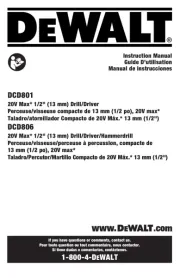
3 Augustus 2025
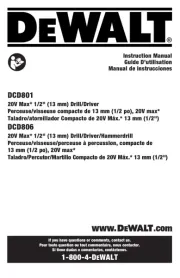
29 Juli 2025

4 Juli 2025
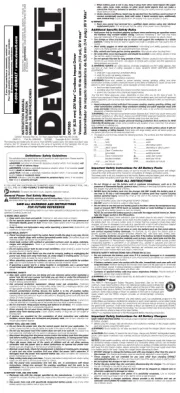
10 Juni 2025

2 Januari 2025

22 November 2024

15 November 2024

2 November 2024

23 September 2024

11 September 2024
Handleiding Boormachine
- Steren
- Wurth
- Baier
- Ferrex
- Milwaukee
- Smart365
- RUKO
- Skil
- Gamma
- Texas
- Lux Tools
- MSW
- Metabo
- Sthor
- Tryton
Nieuwste handleidingen voor Boormachine
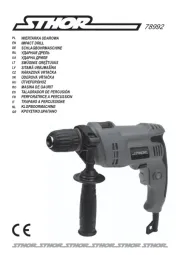
13 September 2025
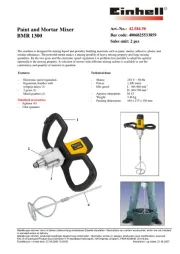
13 September 2025
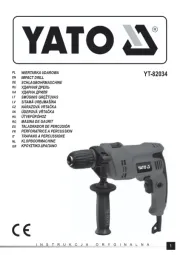
12 September 2025
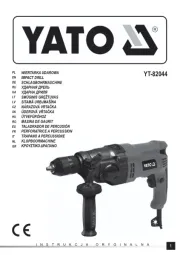
12 September 2025
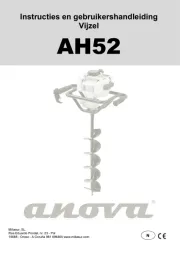
9 September 2025
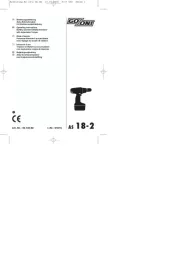
8 September 2025
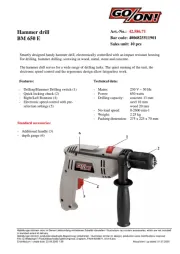
7 September 2025
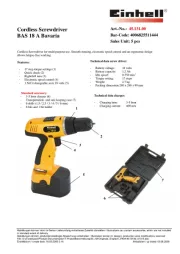
2 September 2025
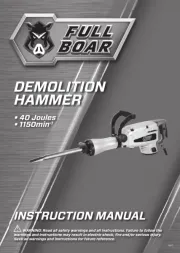
2 September 2025
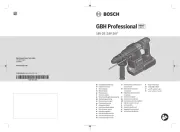
2 September 2025